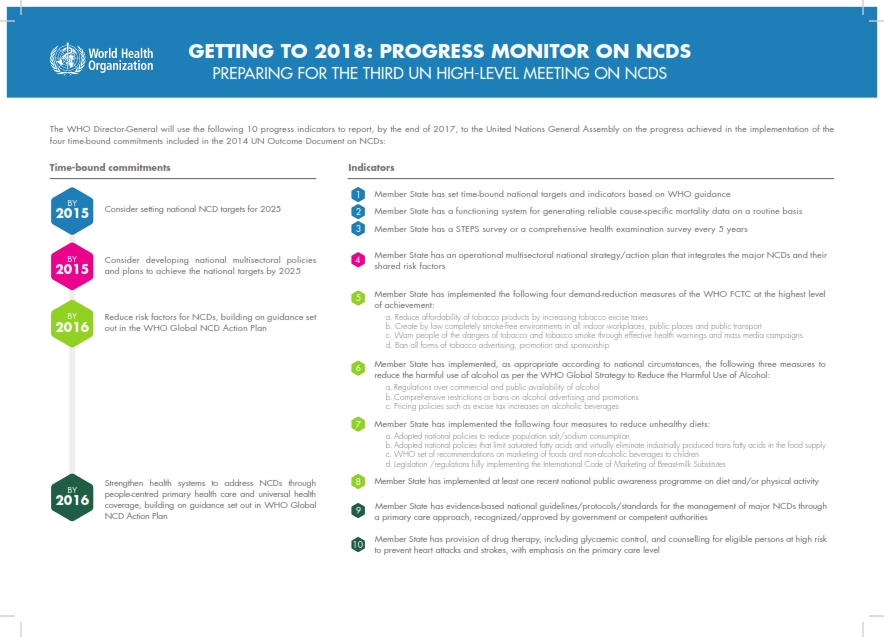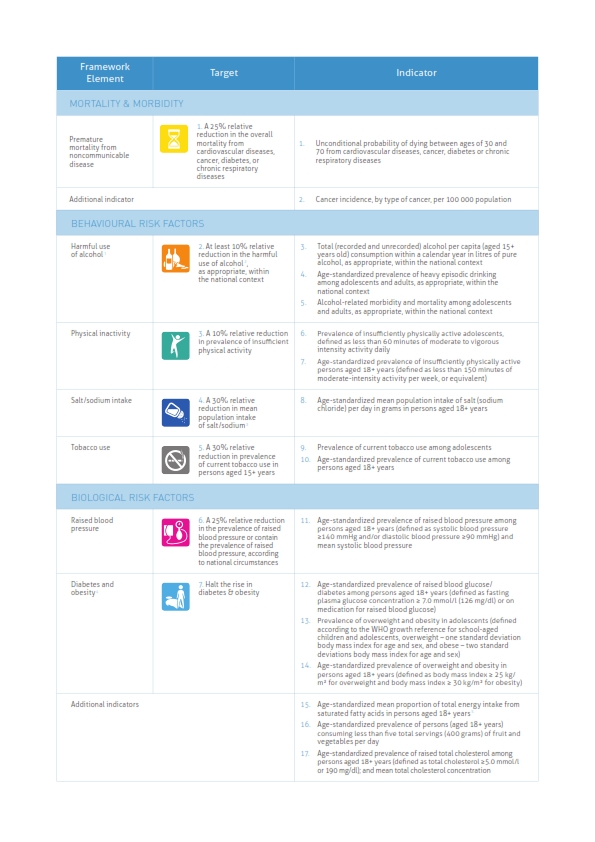Non-communicable disease programme directors and managers convene at the first WHO global meeting in Geneva
From Monday 15 to Wednesday 17 February 2016, the First World Health Organization (WHO) Global Meeting of National Noncommunicable Diseases (NCD) Programme Directors and Managers was convened in Geneva, Switzerland. The meeting provided a key opportunity for national NCD programme directors and managers to exchange local…
From Monday 15 to Wednesday 17 February 2016, the First World Health Organization (WHO) Global Meeting of National Noncommunicable Diseases (NCD) Programme Directors and Managers was convened in Geneva, Switzerland. The meeting provided a key opportunity for national NCD programme directors and managers to exchange local insights and global perspectives on how to strengthen national NCD responses. Additional participants included representatives from United Nations agencies, WHO Collaborating Centres, as well as academic thought leaders on NCDs.
Objectives of the meeting were to:
- Strengthen capacity: To strengthen the capacity of national NCD Programme Managers and Directors to lead efforts and coordinate the multisectoral action required in accelerating the achievement of the four time-bound commitments, including the nine NCD targets in the 2014 United Nations Outcome Document on NCD and the response to the six NCD-related targets in the Sustainable Development Goals (SDGs).
- Catalyze country progress in attaining national NCD targets: To highlight the need to develop and implement coherent and integrated national multisectoral plans and policies, subject to national priorities, to reduce exposure to risk factors and to strengthen health systems, in order to accelerate progress in attaining national NCD targets and the four time-bound commitments in the 2014 United Nations Outcome Document on NCDs.
- Sustain national NCD responses: To highlight the importance of domestic public financing for NCDs through evidence based and innovative strategies, including the potential to increase domestic revenues from taxation on tobacco and alcohol, and to allocate a portion of these domestic proceeds to health. Objectives
- Promote national and global accountability: To strengthen the understanding among national NCD Programme Managers and Directors about national, regional and global accountability frameworks on NCDs, which measures and reports country progress on a regular basis to the World Health Assembly, the United Nations General Assembly and the United Nations Economic and Social Council.
- One-WHO-approach for prevention and control of NCDs: To provide an understanding of the integrated and strategic WHO approach in supporting countries on the prevention and control of NCDs, and an update on existing platforms, tools and guidance in order to better link the demand for support with the wide-range of available WHO resources and resources of United Nations and intergovernmental bodies.
- Join forces and strengthen common understanding: To establish a WHO-led global practice community of national NCD Programme Managers and Directors to exchange knowledge and experiences share resources and create synergies to accelerate country progress in prevention and control of NCDs.
Noncommunicable or chronic diseases kill 38 million people each year. Let’s #beatNCDs https://t.co/rXnPpSe5UX pic.twitter.com/iXAEakQhZO
— WHO (@WHO) February 16, 2016
Learn more about the event with the concept note Arabic | English | Français | ру́сский | Español and overview brochure English | Français| ру́сский | Español
Background
- September 2011, the United Nations General Assembly adopted by consensus the resolution titled Political Declaration of the High-level Meeting of the General Assembly on the Prevention and Control of Non-communicable Diseases (document A/66/L.1) at the High-level Meeting of the United Nations General Assembly on the Prevention and Control of NCDs.
- May 2013, the Sixty-sixth World Health Assembly adopted the comprehensive global monitoring framework (document A/66.8) which was developed by WHO to enable global tracking of progress in preventing and controlling major noncommunicable diseases. The framework comprised of nine global targets and 25 indicators and tracks implementation of the “NCD global action plan” through monitoring and reporting on the attainment of the 9 global targets for NCDs, by 2025, against a baseline in 2010. The Assembly also endorsed the Global action plan for the prevention and control of noncommunicable diseases (2013-2020) (Full document: English / Brochure: English) to operationalise the commitments made in the UN Political Declaration on NCDs. The Action Plan provides a road map and a menu of policy options for all Member States and other stakeholders to take coordinated and coherent action to attain the 9 voluntary global targets.
- Target 1: A 25% relative reduction in the overall mortality from cardiovascular diseases, cancer, diabetes, or chronic respiratory disease
- Target 2: At least 10% relative reduction in the harmful use of alcohol, as appropriate, within the national context
- Target 3: A 10% relative reduction in prevalence of insufficient physical activity
- Target 4: A 30% relative reduction in mean population intake of salt/sodium
- Target 5: A 30% relative reduction in prevalence of current tobacco use in persons aged 15+ years
- Target 6: A 25% relative reduction in the prevalence of raised blood pressure or contain the prevalence of raised blood pressure, according to national circumstances
- Target 7: Halt the rise in diabetes and obesity
- Target 8: At least 50% of eligible people receive drug therapy and counselling (including glycaemic control) to prevent heart attacks and strokes
- Target 9: An 80% availability of the affordable basic technologies and essential medicines, including generics, required to treat major NCDs in both public and private facilities
- July 2014, United Nations General Assembly convened a high-level meeting to undertake a comprehensive review and assessment on the prevention and control of NCDs. Member States unanimously adopted a concise, action-oriented Outcome Document at the UN Review. This Outcome Document includes specific, time-bound commitments that will effectively guide the next phase of the global and national NCD response (document A/68/L.53).
- By 2015, consider setting national NCD targets for 2025
- By 2015, consider developing national multisectoral policies and plans to achieve the national targets by 2025
- By 2016, reduce risk factors for NCDs, building on guidance set out in the WHO Global NCD Action Plan
- By 2016, strengthen health systems to address NCDs through people-centred primary health care and universal health coverage, building on guidance set out in WHO Global NCD Action Plan.
- January 2015, the global status report on prevention and control of NCDs (2014) is framed around the nine voluntary global targets. The report provides data on the current situation, identifying bottlenecks as well as opportunities and priority actions for attaining the targets.
- May 2015 the World Health Organization published a Technical Note on how WHO will report in 2017 to the United Nations General Assembly on the progress achieved in the implementation of national commitments included in the 2011 UN Political Declaration and the 2014 UN Outcome Document on NCDs. The Technical Note included a set of ten progress monitoring indicators which are intended to show the progress achieved in countries in the implementation of the four time-bound commitments for 2015 and 2016 included in the 2014 Outcome Document.
- September 2015, the noncommunicable diseases progress monitor (2015) was launched on the occasion of the 2015 UN Sustainable Development Summit. The focus of the report is on presenting information for each country related to their achievement of these progress monitoring indicators. The profiles also include information on the population, percentage and number of deaths from NCDs, and the probability of premature mortality from NCDs. The data presented in the country pages are derived from several sources, each of which is explained in the following notes.
- A report on the progress achieved in the implementation of the outcome document and of the 2011 Political Declaration will be submitted to the General Assembly, by the end of 2017, in preparation for a comprehensive review in 2018.
Useful links
- Tools for developing, implementing and monitoring the National Multisectoral Action Plan for NCD Prevention and Control: WHO
- Mobile application – the WHO NCD Data Finder – for use on all mobile devices such as smart phones and mobile tablets. The NCD Data Finder presents information on the NCD situation in each country – including data on deaths, risk factors and country systems response. The new app can be downloaded from the following links for either Android or iOS devices: Download the application from Google Play, Download the application from iTunes.
- Noncommunicable diseases and mental health cluster (NMH) – The mission of the NMH is to provide leadership and the evidence base for international action on surveillance, prevention and control of noncommunicable diseases, mental health disorders, malnutrition, violence and injuries, and disabilities. Working jointly with Regional and Country Offices, the NMH Cluster supports Member States in promotiong health and in preventing premature death and disability from these conditions by addressing their risk factors and determinants and improving health care and rehabilitation services. Brochure: Providing global leadership – Noncommunicable Diseases and Mental Health Cluster 2014-2017


